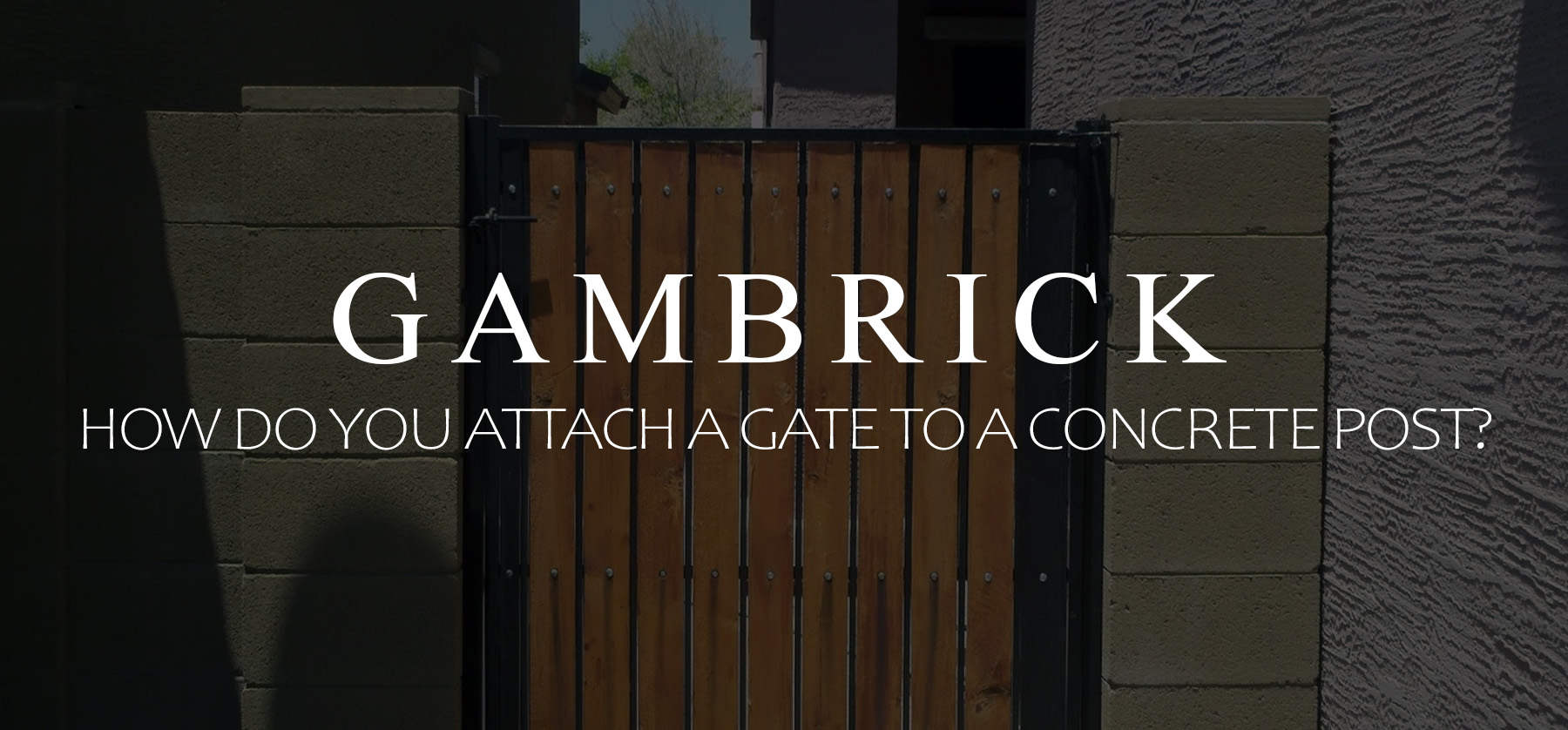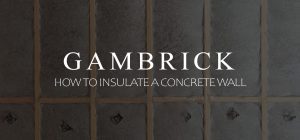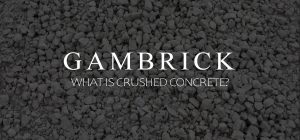
How Do You Attach A Gate To A Concrete Post?
It’s just as easy to attach a gate to a concrete post as it is to wood. Most gates are attached with what’s called a gate screw hook hinge. It’s a special type of strong screw that’s shaped like an L, which supports the hinge and gate. Whether your screwing into a wood post or concrete, hinges work in exactly the same way. First, take some measurements and mark out where you need the hinges to go. Then mark the screw holes. Once the holes are marked you can drill pilot holes into the concrete. Use a power drill, preferably one with a hammer function, and a fresh drill bit. Make sure the hole is exactly the right size for the screw. Concrete isn’t as forgiving as wood, so the hinge holes need to be perfect.
Once all your holes are drilled it’s easy to set the hinges and gate. I’ve been a mason for over 25 years and can tell you firsthand that installing the hinges first and then the gate is easiest. You can install them both together, but hanging them separately is easier.
Make sure you buy screws designed for outdoor use to avoid rusting the concrete. Stainless steel or galvanized are two of my favorites because they don’t rust. You can use concrete screws in wood, but you can’t use wood screws in concrete because the threads won’t hold.
When you attach a gate to a concrete post, it’s the screws and hinges that typically fail over time. So using durable screws and hinges that won’t rust is important.
Secure the screws with a set of pliers or a wrench. Screw until the hinges are tight but don’t over tighten or you can damage the concrete.
Create A Strong Connection
Gates can be very heavy and are a moving part so they need a strong connection. Screws and hinges are where most gates fail over time either because they’re not secured to the post correctly, undersized for the load, or damaged.
Unnecessary wear is one of the most crucial things to avoid if you want your gate to last for a long period of time. When it comes to a concrete post, this means making sure the gate isn’t crushing it back into powder. If the screws don’t fit tightly into the holes there could be movement. Over time, this movement can grind the concrete into powder which weakens the screws bond. Eventually the screws can pull right out of the holes.
Cracks can also form near the screw holes. If this happens, use a concrete crack filler to repair them. This can prevent the cracks from getting worse.
The strongest way to secure screws to concrete is by inserting them before the concrete is fully hardened. By doing this, the concrete dries tightly around the screw. If you can hang your gate on a concrete post before it fully hardens that’s a big advantage.
Concrete is divided into two types: precast and site-cast.
- Precast concrete is concrete that has already been cured and is ready to use. Precast concrete generally requires drilling to hang a gate.
- Site cast concrete is mixed, poured, and cured on site and not in advance. Site cast does not always require drilling because the screws can be installed while the concrete is wet.
Precast concrete posts often contain pre-drilled holes that can be used to insert screws and anchors. This makes gate installation easier.
No matter how you drill your holes, make sure they’re the correct size for the screws or anchors you’re using.
Fasteners for Concrete
Some type of anchors and fastener is required when attaching anything to concrete. The type of anchor and fastener you use will be determined by the weight of your gate as well as the style of hinge. When it comes to attaching your gate to a concrete post, there are three main fasteners to consider.
- Concrete screw.
- Hammer-set anchor.
- Lag screw shield.
Anchors work in combination with a screw. The anchor is inserted into a hole first. Once it’s set in place a threaded screw is used. Anchors push against the sides of the concrete hole as the screw is inserted which creates a very tight bond. A concrete plug is a form of anchor. I recommend using strong metal anchors to attach a gate to concrete and not plastic.
The hammer-set is a fastener that’s mainly used for connecting light objects to concrete. However, if you’re installing a light weight gate they can work. They’re great for small projects because of their simple functionality and low cost. Simply drill a hole in the concrete, place your hinge over it, and begin hammering in the anchor.
The concrete screw is the main type of fastener I use for concrete. They work just like a regular screw. Simply pre-drill the hole and then install the screw. Pre-drilling is very important with concrete screws. The hole has to be the right size for the screw or it won’t function properly.
Attaching A Heavy Gate To Concrete Posts
If you’re attaching a gate to a concrete post that’s heavier than a normal fence gate, I recommend installing lag screws while the concrete is still curing. When we build new homes, the hurricane bolts are inserted into wet concrete for a reason, the hold is much stronger. The concrete can dry around the screws heads which creates a super tight bond.
If I can’t insert the screws while the concrete’s still a little wet, I use lag screws and a metal anchor instead of just a screw. The anchor has edges like teeth that bite into the side of the hole as you install the screw. This makes it almost impossible to pull out without damaging the concrete. It also reduces movement which helps preserve the concrete.
In cases where I use just a screw, I squirt some impact cement into the hole and around the threads of the screw as I insert it. It comes in a tube similar to caulk. When the impact cement dries around the threads and against the concrete it creates a very tight bond. Make sure not to use too much, if you over do it the screw won’t fit inside the hole.
The Most Effective Gate Hinges
There are two main types of hinges used to hang a gate. The fence hinge and the gate screw hook.
- Gate Screw Hooks. These come in light-duty to heavy-duty varieties so there is probably something that will work for your gate. They comes in two pieces. The screw, which is protected by a shield and enters into the concrete fence, and the hook, which is attached to the gate itself. I’ve used gate screw hooks before and they work just fine, but I prefer the fence hinge. Especially if the gate is heavy. Gate screw hooks can allow the gate to swing in both directions.
- Fence Hinge. These work just like a door hinge. There are two sides to it. One side will attach to the gate, while the other will attach to the post. Hinges are very strong and durable. They come in a wide variety of sizes which can work for any size or design door. Whenever I attach a gate to a concrete post, I always use a good sturdy hinge. A fence hinge only allows the gate to swing in one direction.
Whichever type of fastener you choose, make sure it’s sized properly for the gate your installing.
Make sure you use fasteners that are approved for concrete. If you buy a standard fence hinge, you’ll probably have to replace the standard screws for concrete screws. In general, assume screws are meant for wood unless otherwise stated.
Installing gate screw hooks is a little more forgiving than hinges. Most hinges have 3 screws. The holes all have to be in the exact correct position for the screws or the hinge won’t function properly. But gate screws typically have one screw per hook which makes lining up and drilling easier.
Concrete Equipment
Hanging a gate from a concrete post requires a few special tools that’ll make the job easier.
Drilling holes into concrete requires a special concrete drill bit. These are generally sold right next to the concrete screws at the Home Depot. Typically they’ve got a reinforced tip and diamond dust coating that allows them to chew through concrete.
With the right bit, almost any drill can make a small hole in concrete. But for medium to large sized holes, you should use a hammer drill. Hammer drills are specialized for masonry work. They not only turn the bit but also hammer it in and out which helps drive into the concrete and break up stone.
Masonry drills are also heavier than a standard household screw gun. They have more torque and won’t burn out as easily.
When drilling into concrete you should use a mask. Concrete dust can be bad for your health.
Use some water as you drill. Pour a small amount onto the bit and hole. This will cut down on dust and cool the bit. Drill bits are easy to overheat. In some cases they can even get red hot which makes them break apart. And they’re not cheap, so help them last by keeping them cool.
Attach A Gate To A Concrete Post With Wood
Another way to attach a gate to a concrete post is with wood. The wood is attached to the concrete and the gate to the wood. This allows you to use standard wood screws for your hinges.
A wooden board can be attached to your concrete post with anchors or screws. I don’t recommend using concrete nails because the weight of the gate could pull them out. This method allows the gate to be attached to wood rather than concrete.
A benefit to using wood to help secure the gate is flexibility. If your new gate isn’t exactly the right size for the opening what do you do? A solution is padding the opening with some wood before installing the gate.
Make sure you only use wood that’s safe for the outdoors. Treated wood work fine but I prefer wood that’s naturally resistant to the elements like cedar.
Use wood that’s strong enough to support the weight of the gate. Since the gate’s weight will now be on the wood, you need it to be strong. Wood adds another point that can potentially fail. If the gate is too large for the wood you could crack it.
Appearance is an important consideration too. Choose a wood that matches the look of the gate.
If you want to hide the fasteners holding the wood to the concrete post, install them behind the fat part of the hinge. Typically a hinge has 3 screw holes. Don’t put the install screws behind these. Instead, hide them behind the areas where there are no holes. If done correctly it’ll appear as if the wood is glued to the concrete post rather than screwed.
Summary: How Do You Attach A Gate To A Concrete Post?
It’s just as easy to attach a gate to a concrete post as it is to wood. Most gates are attached with what’s called a gate screw hook hinge. It’s a special type of strong screw that’s shaped like an L, which supports the hinge and gate. Whether your screwing into a wood post or concrete, hinges work in exactly the same way. First, take some measurements and mark out where you need the hinges to go. Then mark the screw holes. Once the holes are marked you can drill pilot holes into the concrete. Use a power drill, preferably one with a hammer function, and a fresh drill bit. Make sure the hole is exactly the right size for the screw. Concrete isn’t as forgiving as wood, so the hinge holes need to be perfect.
Once all your holes are drilled it’s easy to set the hinges and gate. I’ve been a mason for over 25 years and can tell you firsthand that installing the hinges first and then the gate is easiest. You can install them both together, but hanging them separately is easier.
Make sure you buy screws designed for outdoor use to avoid rusting the concrete. Stainless steel or galvanized are two of my favorites because they don’t rust. You can use concrete screws in wood, but you can’t use wood screws in concrete because the threads won’t hold.
When you attach a gate to a concrete post, it’s the screws and hinges that typically fail over time. So using durable screws and hinges that won’t rust is important.
Secure the screws with a set of pliers or a wrench. Screw until tight but don’t over tighten or you can damage the concrete.
If you have any questions email or leave a comment below.

John Mazzuca | About | More Posts |
Custom Home Builder
John Mazzuca is a custom home designer and builder at Gambrick with over 25 years experience in the construction industry. John has designed, built and/or remodeled hundreds of homes, small buildings, and commercial projects. He writes about business, real estate, home building, and household electronics. His work has been featured in Fox Business, Better Homes & Garden, House Beautiful, and more.




















